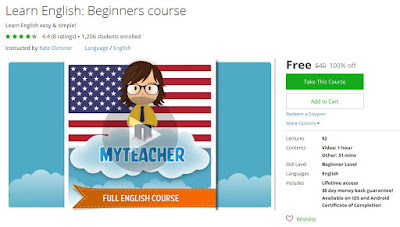Course Description
This “Beginners" Course is focused on learning Basic English
structures, grammar, vocabulary, listenings, readings, pronunciation,
translations, dictations, spellings and it is equivalent to
- The “Starters" level from the Cambridge University in the UK.
- The A1 level in the Common European Framework of Reference for Languages (CEFR).
- A 0-56 points at the TOEFL exam (Test Of English as a Foreign Language).
- WHAT WILL YOU LEARN: (COURSE CONTENT)
In this Beginner course you will learn a lot of basic grammar, like
how to identify a subject, the determiners a, an, the or nothing, the
demonstrative pronous (this, that, these, those). We will show you how
to structure a sentence in the correct way. The possessive "´s", the
Present Simple, how to create a question using our "WASV?" and the
Adverbs of Frequency.
The verbs "There is" and "There are", how to use the quantitatives
"some" and "any", "much", "many" and "a lot of" and the interrogative
pronouns "How much" and "How many". You will learn some verb tenses for
the future like the Present Continuous and the structure "to be going
to", the differences in use and grammar between the Present Simple and
the Present Continuous, the modal verb "Can". You will also know how to
create the Comparatives and Superlatives adjectives, and what to do when
we want to say two verbs together.
Course Details
DictationFREE DISCOUNT COUPON
Grammar: A little, a few
Grammar: Adverbs of Frequency
Grammar: Adverbs of Frequency (1)
Grammar: Adverbs of Frequency (2)
Grammar: Can
Grammar: Comparatives & Superlatives
Grammar: Comparatives & Superlatives (1)
Grammar: Comparatives & Superlatives (2)
Grammar: Demonstrative Pronouns (This, That, These, Those)
Grammar: Demonstrative Pronouns (This, That, These, Those)
Grammar: Determiners: a /an, the, nothing
Grammar: Determiners: a /an, the, nothing
Grammar: Differences Present Simple vs Present Continuous
Grammar: Differences Present Simple vs Present Continuous (1)
Grammar: Differences Present Simple vs Present Continuous (2)
Grammar: Differences Present Simple vs Present Continuous (3)
Grammar: How much / How many
Grammar: How much / How many
Grammar: How to create a sentence in English
Grammar: How to create a sentence in English
Grammar: How to identify a subject
Grammar: Interrogative Pronouns
Grammar: Interrogative Pronouns
Grammar: much / many / a lot of
Grammar: much / many / a lot of (1)
Grammar: much / many / a lot of (2)
Grammar: Present Continuous & be going to
Grammar: Present Continuous & be going to (1)
Grammar: Present Continuous & be going to (2)
Grammar: Present Simple
Grammar: Present Simple & the verb to be
Grammar: Present Simple (1)
Grammar: Present Simple (2)
Grammar: Pronouns and Possessives
Grammar: Some / Any
Grammar: Some / Any 1
Grammar: Some / Any 2
Grammar: Subjects and the verb to Be
Grammar: Subjects and the verb to Be
Grammar: The possessive genitive: ´s
Grammar: The WASV Formula (1)
Grammar: The WASV Formula (2)
Grammar: The WASV formula to create questions
Grammar: There is / are
Grammar: There is / are (1)
Grammar: There is / are (2)
Grammar: too much or too many?
Grammar: Useful English structures
Grammar: Useful English structures
Intro Lecture
Listening
Listening 1
Listening 2
Pronunciation
Reading
Reading 1
Reading 2
Reading comprehension quiz
Reading comprehension quiz (1)
Reading comprehension quiz (2)
REVISION EXAM 1
Section 1: STARTER UNIT
Section 2: UNIT 1
Section 3: UNIT 2
Section 4: UNIT 3
Section 5: REVISION EXAM 1
Section 6: UNIT 4
Section 7: UNIT 5
Section 8: UNIT 6
Section 9: UNIT 7
Spelling words
The verb Have got
The verb Have got
Vocabulary Book: All the vocabulary necessary for this course
LINK FOR THE FREE COURSE
Udemy free course, Udemy free courses, Udemy free online courses, Udemy online, Udemy online course, Udemy online courses, Udemy online courses review, Udemy reviews, Udemy tutorial, Udemy tutorials, Udemy.com free courses,


No comments:
Post a Comment
Note: only a member of this blog may post a comment.